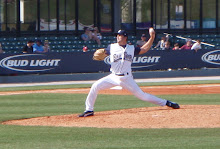
As we head closer to the first game of Spring Training 2010, I am excited to continue studying the mechanics of the many great pitchers in the game today. This week, we look at one of the most unlikely success stories of recent memory. Unheralded and undersized from an mediocre baseball school, his funk mechanics completely contradicted the velocity that exploded out of his skaterboish frame. When I pitched against Tim Lincecum in the Cape Cod Summer League, scouts were unsure if his diminutive stature could hold up to the wear and tear of a big league season. To prove them wrong, he would start on his usual start date and then during his mid-week recovery, he would close games out with identical velocity. Fast forward to 2010 and any scout of wrote him off as too risky are kicking themselves after one of the finest seasons from any starter on any team, any where. Posting a record of 15 -7 with a 2.43 ERA, "The Freak" as he is now called, was awarded his second Cy Young Award in as many years. So now we have a look at his unorthodox motion and break him down: Big Leaguer style.
Check out this video of slo motion Tim Lincecum in action to get an idea of how he generates his velocity.
I guess technically, the video isn't in slow motion, but it gives enough repetitions to get an idea of what we are looking at. Hopefully, you can see by the first still frame that Tim's body posture and angle are different from "typical" mechanics. The video talks about full body throwing and I tend to agree that Lincecum does exemplify how to use ones full body very well to generate velocity.
If we stop the video at the 8 second mark, we see one of my favorite stopping places in a delivery, the leg lift. Here, Tim's upper half has completely rotated inward, showing his back to the hitter. His hands are slightly up and back, but he stands very tall on his back leg. I've said many times, that upper half rotation is very dangerous, because, as the pitcher's body moves forward and uncoils to release the ball, its very difficult to repeat any type of release point. Contrary to this, Tim's body stays on line all the way through...albeit, a rather indirect line.
At the 9 second mark, we see a couple huge "errors" in his delivery. He collapses terribly on his back leg, his front side closes off, his shoulders are tilted WAY back, his throwing arm is down, front arm is high, and he isn't stepping anywhere near the target. That being said.....he might be one of the most "athletic" pitchers in the game. Because, despite all of these perceived flaws, he manages to allow his front hip to lead down the mound and utilizes a fantastic lower half (read, hip turn) to get back on top of the baseball and throw in the mid 90s. Let's fast forward to the side view to see what I mean. Starting at the 0:35 mark, we see how well he rides that front hip and, despite leaning back on his heals most of the delivery, explodes over that front foot and exaggerating his front shoulder over the top side.
Taking it a step further, the 0:38 mark shows just how quickly Tim is able to get his elbows up to shoulder height. Although his upper half is leaning back (outside of his heels), the front foot is getting down in good timing and his momentum will allow him to get his upper half over that front foot despite the poor angel of his body. Much of his ability to generate velocity does indeed come from the momentum derived from the high leg kick driving down and out toward the plate. You may remember from a while back a commercial showing a home video of Tim's dad showing a young Tim how to use the glove side to get the chest square and finish down over that leg. As we see in the video, the glove drive down definitely plays a huge role in allow for him to create that last extra turn to square to the target and finish his pitch. Check out the 44 second mark to see, much to the surprise of anyone who teaches pitching, Tim is able to get completely squared to the target and get fantastic finish on his pitch.
I wouldn't be able to teach how to pitch like Tim Lincecum. Still, much can be learned about developing a momentum filled, athletic delivery from "The Freak." Of course, in quality Major League fashion, he is able to repeat his delivery impeccably. I would go so far as to say there are only a few people in the game who can replicate these mechanics. There is another great youtube video that shows some similarities between him and Yovani Gallardo.
Either way, make sure to study how well he generates velocity through a momentum filled delivery. Be sure to note that it will be very difficult to mimic everything he does. Even so, take not the uniqueness of his delivery.
Until Next Time!!!


